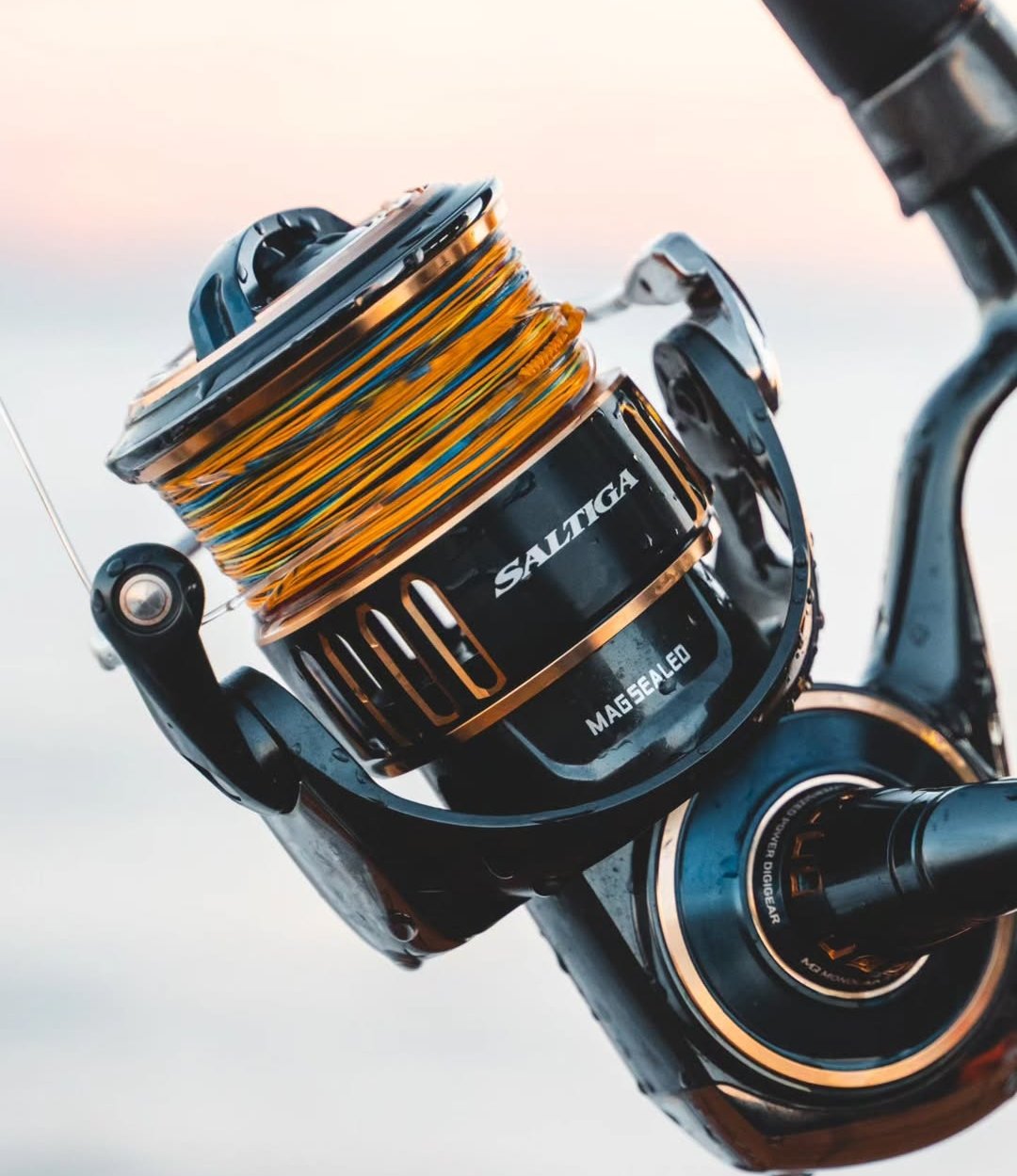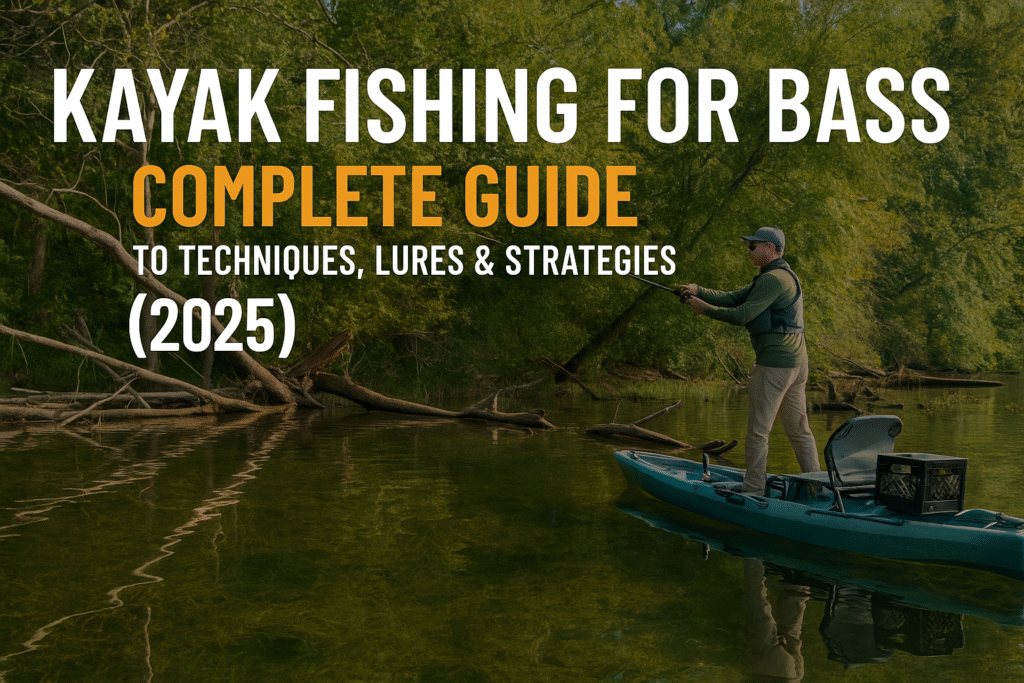
The moment I realized kayak fishing had changed my bass game forever was when I caught a 6-pound largemouth from a pocket so shallow and tight that powerboats couldn’t even see it from the main lake—proving that the best bass fishing often happens where only kayaks can go. That trophy bass was hiding in just 18 inches of water, tucked behind a fallen tree in a cove so narrow I had to duck under overhanging branches to reach it.
After fifteen years of bass fishing from traditional boats and the last eight years perfecting kayak bass fishing techniques, I’ve discovered that kayaks offer unmatched advantages for targeting largemouth bass. The stealth approach, precise positioning, and access to untouched waters have completely transformed how I think about bass fishing strategy.
Kayak fishing provides unique benefits that even the most expensive bass boats can’t match. You can silently drift into shallow spawning areas, position yourself perfectly along structure edges, and access remote waters that see minimal fishing pressure. The learning curve is manageable—most traditional bass fishing knowledge transfers directly to kayak applications with some tactical adjustments.
What started as casual weekend fishing has evolved into tournament competition and year-round bass pursuit. The kayak bass fishing community continues growing rapidly, with dedicated tournaments and specialized gear constantly improving. Whether you’re transitioning from boat fishing or starting fresh, mastering kayak bass fishing opens up endless opportunities to catch more bass in waters others can’t reach.
This comprehensive guide will take you through every aspect of successful kayak bass fishing, from fundamental gear selection to advanced tournament strategies, ensuring you develop the skills needed to consistently catch more bass from your kayak.
Key Takeaways

- Stealth and access are your biggest advantages – Kayaks allow silent approaches to shallow water and tight cover where bass boats cannot go, giving you access to less pressured fish
- Standing up transforms your fishing effectiveness – Learning to stand safely in your kayak dramatically improves casting accuracy, hook-setting power, and fish fighting capability
- Seasonal pattern adaptation is crucial – Bass behavior changes throughout the year, and kayak anglers must adjust positioning, lure selection, and techniques accordingly
- Proper gear selection maximizes efficiency – Choosing the right rods, reels, and tackle storage systems specifically for kayak fishing prevents fatigue and increases fishing time
- Safety preparation enables confidence – Understanding weather patterns, emergency procedures, and navigation skills allows you to fish effectively while staying safe
Why Kayaks Are Bass Fishing Game-Changers: Advantages Over Boat Fishing
The fundamental advantage of kayak fishing for bass lies in what I call the “stealth factor.” Unlike bass boats with loud outboard motors, kayaks allow you to approach bass without alerting them to your presence. This stealth approach is absolutely critical when targeting pressured bass in clear water or shallow spawning areas.
🎯 Stealth Approach Benefits:
- Silent entry into fishing areas
- Minimal water disturbance
- Ability to keep noise and boat-to-boat chatter to a minimum
- Less spooking of fish in high-pressure lakes
The shallow water access advantage cannot be overstated. I regularly fish areas with just 12-18 inches of water depth—zones completely inaccessible to traditional bass boats. These shallow areas often hold the most active bass, especially during spring spawning and fall feeding periods. Your kayak becomes a tool for reaching untouched bass populations.
Precise positioning represents another game-changing advantage. Placing your kayak in the proper location allows you to spend more time and energy fishing and less paddling. You can position yourself to drift along structure edges, maintain perfect casting angles, and stay in the strike zone longer than boat anglers who must constantly adjust their trolling motor.
The cost effectiveness of kayak bass fishing opens opportunities for anglers who cannot afford bass boats. A quality fishing kayak costs a fraction of a bass boat while providing access to the same fish. No boat payments, insurance, or gas expenses means more money for tackle and more time on the water.
Versatility extends your fishing opportunities across multiple water types. The same kayak that excels on large reservoirs works equally well on small ponds, rivers, and even saltwater environments. This multi-water capability maximizes your fishing opportunities throughout the year.
Essential Kayak Bass Fishing Gear: Rods, Reels, and Tackle
Rod selection for kayak bass fishing requires balancing performance with practicality. I recommend 6’6″ to 7′ medium-heavy rods as the sweet spot for most kayak applications. Longer rods provide better casting distance and leverage, but become unwieldy in tight spaces or when fighting fish from a seated position.
For kayak fishing rod setups, consider these configurations:
- Spinning setup: 6’9″ medium rod with 2500-3000 size reel for finesse techniques
- Baitcasting setup: 7′ medium-heavy rod with 7:1 gear ratio reel for power fishing
- Versatile combo: 6’6″ medium-heavy rod that handles both techniques effectively
Reel requirements focus on smooth drag systems and reliable performance. Kayak fishing puts extra stress on reels due to different fighting angles and potential water exposure. Choose reels with sealed bearings and corrosion-resistant components. The best fishing kayak paddle becomes crucial when you need to chase fish or reposition quickly.
Line choices depend on fishing conditions and techniques:
- Fluorocarbon: 12-15lb for clear water finesse fishing
- Braided line: 30-50lb for heavy cover and structure fishing
- Monofilament: 10-12lb for topwater and suspending lures
Tackle storage systems must be waterproof and easily accessible from your seated position. Avoid tackle boxes that require standing to access. Instead, use tackle bags with multiple compartments or kayak-specific tackle storage systems that mount within easy reach.
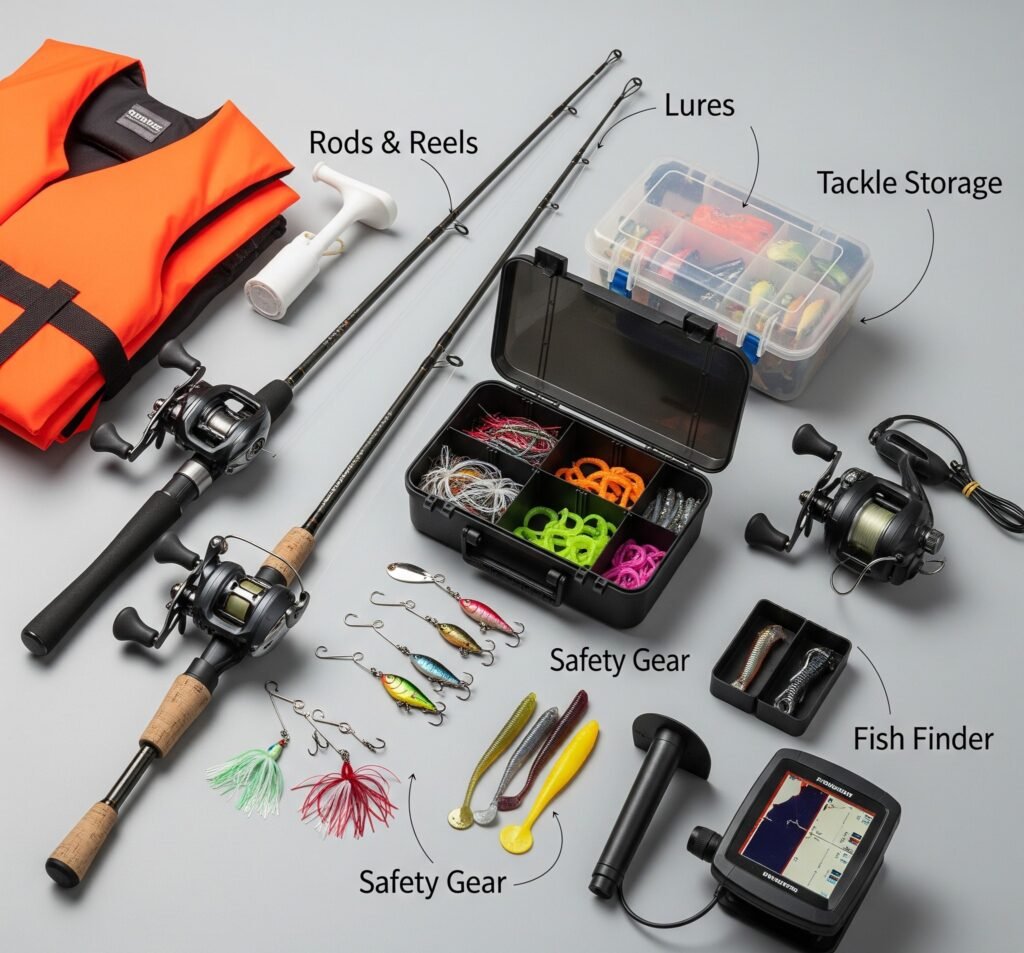
Top Bass Lures for Kayak Fishing: What Works from a Kayak
Search baits form the foundation of successful kayak bass fishing. Spinnerbaits, swimbaits, and crankbaits allow you to cover water efficiently while locating active fish. The key difference in kayak fishing is your ability to work these lures through areas boats cannot access.
🎣 Essential Search Baits:
- Spinnerbaits: 3/8 to 1/2 oz with willow leaf blades for clear water
- Swimbaits: 4-5 inch paddle tail baits for realistic baitfish imitation
- Crankbaits: Square-bill and medium-diving models for structure contact
Finesse lures become incredibly effective when fished from kayaks due to your stealth advantage. Texas rigged worms, soft-plastic jerkbaits, and jigs work exceptionally well when you can position your kayak for perfect presentations without spooking fish.
The topwater excellence of kayak fishing cannot be understated. Your silent approach allows you to work topwater lures in areas where boat noise would eliminate strikes. Spinnerbaits with surface retrieves, square-bill crankbaits, and poppers create explosive action when bass haven’t been alerted to your presence.
Structure baits require precise positioning that kayaks provide perfectly. Jigs and Carolina rigs work best when you can maintain position along structure edges. Your kayak allows you to feel bottom composition and structure changes more intimately than boat fishing.
Seasonal adaptations become crucial for consistent success:
| Season | Primary Lures | Key Techniques |
|---|---|---|
| Spring | Topwater lures, suspending jerkbaits, spinnerbaits | Shallow water sight fishing |
| Summer | Deep diving crankbaits, Carolina rigs, drop shots | Structure and thermocline fishing |
| Fall | Spinnerbaits with willow blades, swimbaits | Following baitfish schools |
| Winter | Jigs, small worms, suspending jerkbaits | Slow, precise presentations |
Color selection depends on water clarity and seasonal patterns. In clear water, natural colors like green pumpkin and watermelon work best. Stained water calls for brighter colors like chartreuse and white. Seasonal color changes follow baitfish patterns—match the shad in fall and crawfish in spring.
Recommended Lures
Select your fishing conditions above to get personalized lure recommendations for kayak bass fishing.
Kayak Bass Fishing Techniques: Mastering Unique Presentations
Positioning strategies separate successful kayak anglers from those who struggle. Finding the structure you want to fish and positioning your kayak to drift your tackle along the edge of cover or drop-offs requires understanding wind, current, and bass behavior. I spend considerable time studying structure before making my first cast.
The ability to stand up in your kayak transforms your fishing effectiveness. Walking a topwater lure, working a jerkbait, and flipping and punching techniques require you to stand for optimal rod angle and hook-setting power. Practice standing techniques in calm water before attempting them in fishing situations.
🎯 Standing Technique Benefits:
- Improved casting accuracy and distance
- Better hook-setting angle and power
- Enhanced fish fighting capability
- Superior line management
Stealth approaches become second nature with practice. Quieting your boat down as much as you can when you fish the shallows means eliminating paddle drip, avoiding hull contact with structure, and minimizing movement. Turn off electronics when approaching shallow areas to eliminate any noise.
Current and wind management turns natural forces into fishing advantages. Use wind to drift along structure edges while maintaining lure contact. Current creates natural presentations that trigger strikes. Position your kayak to use these forces rather than fighting them.
Multi-technique strategies maximize your time in productive areas. After catching active fish, backtrack with a small jig, drop-shot, or other finesse bait to catch additional bass. This systematic approach often doubles your catch from prime locations.
Seasonal Kayak Bass Fishing Patterns: Year-Round Success
Spring pre-spawn periods offer some of the best kayak bass fishing opportunities. Bass move into shallow staging areas adjacent to spawning flats. Your kayak’s stealth advantage allows you to work these areas without spooking fish. Focus on the first warm days when water temperatures reach the mid-50s.
During the spring spawn, sight fishing becomes incredibly effective from kayaks. Your low profile and silent approach allow you to spot bedding bass and present baits accurately. Use polarized sunglasses and position yourself to minimize your shadow on the water.
Summer patterns require adapting to deeper water and structure fishing. Deep-water summer lures include Carolina-rigged worms, small finesse baits, and spoons. The key is finding thermoclines and structure where bass suspend during hot weather. Your fish finder for kayak fishing becomes crucial for locating these areas.
Fall feeding periods provide explosive action when you can locate baitfish schools. Concentrate on using shad or baitfish style baits as bass feed heavily before winter. The bite will usually last all day during prime fall periods, making it ideal for kayak fishing marathons.
Winter tactics focus on deep structure and slow presentations. Bass metabolism slows dramatically, requiring patience and persistence. Small jigs, drop shots, and suspending jerkbaits work best when presented slowly around deep structure.
Weather adaptations become crucial for consistent success:
| Weather Pattern | Bass Behavior | Kayak Strategy |
|---|---|---|
| Stable High Pressure | Deep, inactive | Finesse techniques, slow presentations |
| Falling Barometer | Shallow, active | Aggressive baits, topwater action |
| Cold Front | Deep, tight to cover | Small baits, precise presentations |
| Warm Front | Shallow, feeding | Fast-moving search baits |
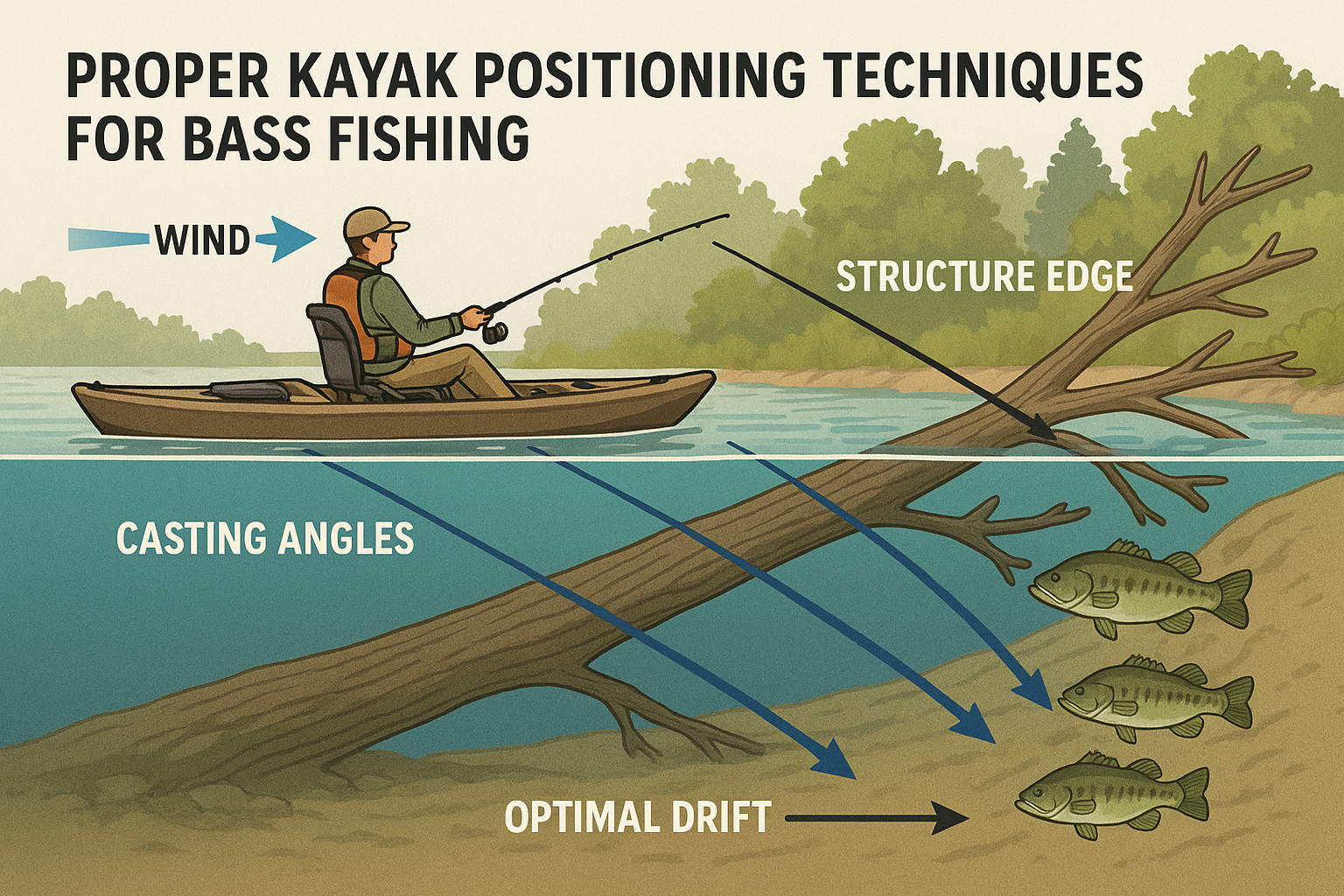
Structure and Cover: Reading Water from a Kayak
Shallow cover fishing represents where kayaks truly excel. Wood, vegetation, and rock formations in shallow water hold bass that rarely see lures due to boat access limitations. Your kayak allows you to work these areas thoroughly with precise presentations.
Deep structure requires different approaches but remains highly productive. Points, ledges, and drop-offs concentrate bass during certain seasons. Use your electronics to identify structure, then position your kayak for optimal lure presentations along structure edges.
Transition areas connecting shallow and deep water often hold the most bass. These zones see bass movement throughout the day as fish move between feeding and resting areas. Your kayak can work these transitions more effectively than larger boats.
Seasonal movement patterns determine where bass use structure differently throughout the year. Spring finds bass moving shallow along migration routes. Summer pushes them to deeper structure with current or shade. Fall brings them back to shallow structure following baitfish.
Electronics integration maximizes your structure fishing success. Modern fish finders show structure composition, fish location, and bottom hardness. Learn to interpret these signals to identify the most productive areas.
Kayak positioning requires understanding optimal angles and drift patterns. Position yourself upwind or up-current from structure to maintain natural lure presentations. Practice controlling your drift speed with paddle adjustments and body positioning.
Advanced Kayak Bass Techniques: Tournament-Level Strategies
Pattern development separates tournament anglers from recreational fishermen. Identifying and exploiting bass patterns requires systematic approaches to lure selection, structure analysis, and seasonal timing. Keep detailed logs of successful patterns for future reference.
Time management becomes crucial when fishing tournaments from a kayak. Maximize fishing time by pre-planning routes, organizing tackle efficiently, and minimizing travel between spots. Every minute spent paddling is time not fishing.
Lure rotation follows systematic approaches rather than random changes. Start with search baits to locate fish, then switch to finesse presentations for additional catches. Have backup lures ready for different conditions or fish moods.
Backup plans prepare you for changing conditions or unproductive primary spots. Develop secondary patterns and locations before tournaments. Weather changes or fishing pressure can make backup plans essential for success.
Tournament rules specific to kayak competitions differ from boat tournaments. Understand measuring procedures, safety requirements, and equipment restrictions. Many tournaments require specific safety gear and communication devices.
Efficiency techniques focus on covering water while staying organized. Use rod holders to keep multiple setups ready. Organize tackle for quick access. Plan routes to minimize paddling time between productive areas.
Safety and Navigation: Staying Safe While Bass Fishing
Weather awareness becomes critical for kayak safety. Thunderstorms pose serious threats with lightning and sudden wind changes. Monitor weather forecasts and have evacuation plans for severe weather. Never fish during thunderstorm warnings.
Navigation skills prevent dangerous situations and improve fishing efficiency. GPS units designed for kayaks provide navigation and mark productive spots. Learn traditional navigation techniques as backup for electronic failures.
Emergency procedures prepare you for self-rescue situations. Practice re-entering your kayak from the water. Carry whistle, flare, or other signaling devices. Inform others of your fishing plans and expected return times.
Shallow water hazards include stumps, rocks, and vegetation that can damage your kayak or cause injury. Learn to read water for hidden obstacles. Carry repair supplies for minor hull damage.
Seasonal safety considerations change throughout the year. Cold water requires appropriate kayak fishing apparel and hypothermia awareness. Hot weather demands sun protection and hydration planning.

Equipment redundancy provides backup systems for critical safety gear. Carry backup paddle, communication device, and navigation tools. Equipment failures in remote areas can become dangerous without proper preparation.
Kayak Selection for Bass Fishing: Choosing the Right Platform
Stability requirements for bass fishing exceed basic paddling needs. Standing and casting create different stability demands than recreational kayaking. Test kayaks for standing stability before purchasing. The Native Watercraft Ultimate FX 12 exemplifies kayaks designed specifically for fishing applications.
Storage needs include rod holders, tackle storage, and electronics mounting. Consider how much gear you typically carry and ensure adequate storage space. Waterproof storage protects electronics and tackle from water exposure.
Speed vs. stability trade-offs affect your fishing style. Faster kayaks cover water quickly but may sacrifice stability. Stable platforms fish better but move slower between spots. Choose based on your primary fishing style and water types.
Electronics integration capabilities vary significantly between kayak models. Consider fish finder mounting options, battery storage, and cable routing. Some kayaks include factory electronics packages that simplify installation.
Budget considerations balance features with cost. Entry-level fishing kayaks start around $500, while premium models exceed $3000. Determine essential features versus nice-to-have options for your budget.
Multi-water capability extends your fishing opportunities. Kayaks that perform well on lakes, rivers, and coastal waters provide maximum versatility. Consider the variety of waters you plan to fish when selecting your kayak.
Common Mistakes and Solutions: Avoiding Kayak Bass Fishing Errors
Positioning errors represent the most common kayak fishing mistakes. Poor kayak placement and presentation angles reduce fishing effectiveness dramatically. Spend time learning optimal positioning before focusing on lure selection or technique refinement.
Noise management becomes critical on high-pressure lakes where bass see significant fishing pressure. Keep your transducer off and eliminate paddle drip when approaching shallow areas. Even small noises can spook bass in clear, shallow water.
Lure selection mistakes often involve mismatching lures to conditions and structures. Use search baits to locate fish before switching to finesse presentations. Match lure size and action to bass activity levels and seasonal patterns.
Technique execution errors include improper casting angles, poor hook sets, and inadequate fish fighting techniques. Practice casting from seated and standing positions. Learn proper hook-setting angles for different lure types.
Time management inefficiency wastes productive fishing time. Plan routes to minimize travel time between spots. Organize tackle for quick access. Avoid spending too much time in unproductive areas.
Equipment issues can ruin fishing trips without proper preparation. Carry backup gear for critical items. Maintain equipment regularly to prevent failures. Learn basic repair techniques for common problems.
Trophy Bass from Kayaks: Targeting Big Fish
Habitat selection for trophy bass focuses on prime locations with minimal fishing pressure. Large bass often inhabit areas difficult for boat anglers to reach effectively. Your kayak provides access to these trophy bass sanctuaries.
Lure sizing for trophy bass often means using larger baits than typical bass fishing. Big bass prefer substantial meals, especially during feeding periods. Don’t be afraid to use large swimbaits, magnum spinnerbaits, and oversized soft plastics.
Presentation modifications for trophy bass require slower, more deliberate approaches. Large bass didn’t grow big by being careless. Use longer pauses, slower retrieves, and more natural presentations when targeting trophy fish.
Seasonal timing affects when trophy bass are most catchable. Pre-spawn periods offer excellent opportunities as large females move shallow. Fall feeding periods also provide chances at trophy bass as they prepare for winter.
Fight management becomes crucial when hooking large bass from a kayak. Use proper drag settings and fighting techniques to prevent break-offs. Learn to manage your kayak position during fights to maintain control.
Conservation ethics ensure trophy bass populations remain healthy for future anglers. Practice catch and release for large bass. Handle fish carefully and release them quickly to maximize survival rates.
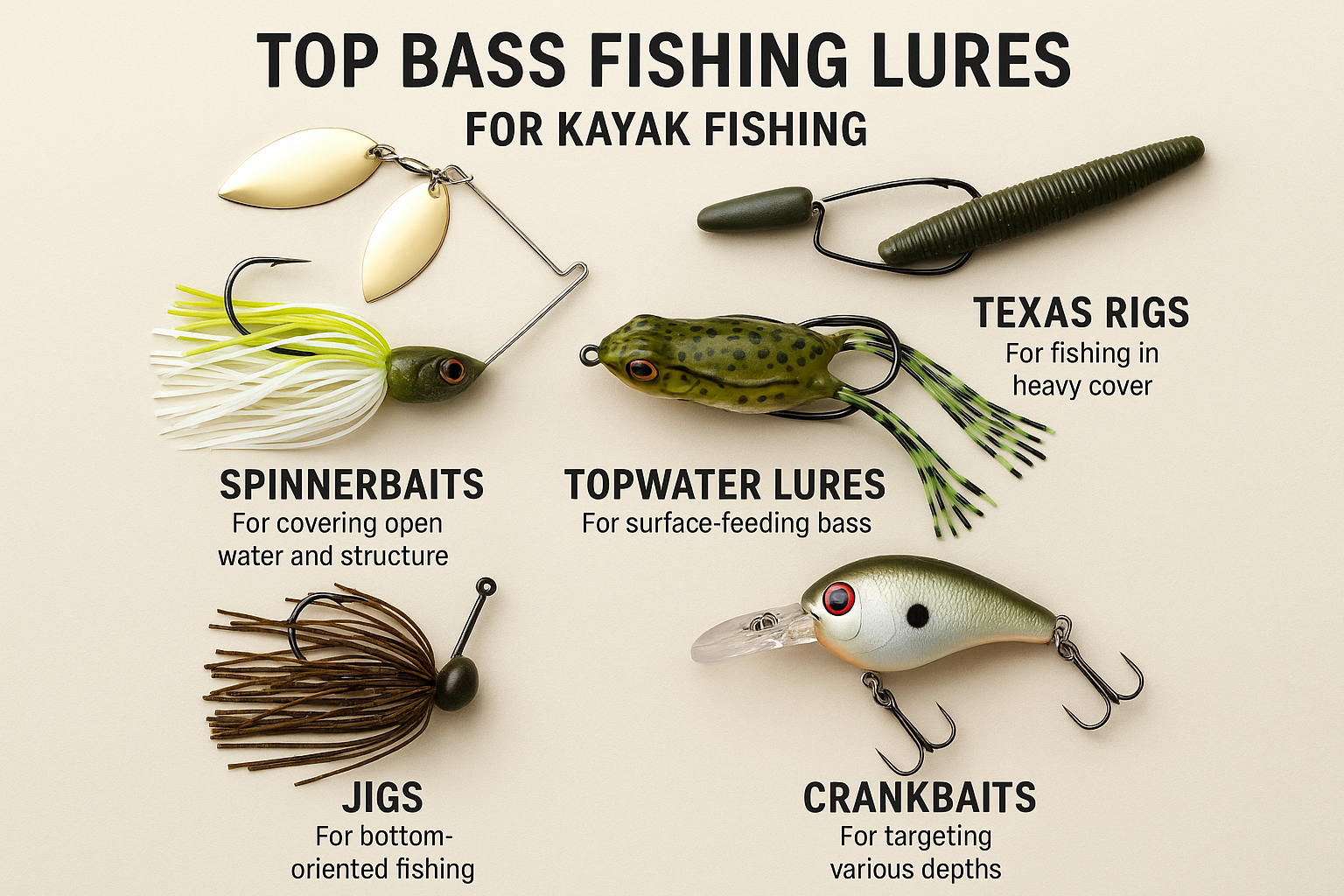
Learning to effectively stand up in a kayak for fishing dramatically improves your ability to fight and land trophy bass. The improved leverage and line management capabilities make a significant difference when battling large fish.
Regional Considerations and Opportunities
Different regions offer unique kayak bass fishing opportunities that require adapted strategies. Kayak fishing in North Carolina provides diverse waters from mountain lakes to coastal rivers, each requiring different approaches and techniques.
Coastal areas like Hilton Head Island kayak fishing offer brackish water bass fishing opportunities that many anglers overlook. These areas often hold larger bass due to abundant forage and less fishing pressure.
Regional patterns vary based on climate, water types, and local forage species. Northern lakes may have different seasonal timing than southern reservoirs. Learn local patterns and adapt your techniques accordingly.
Local regulations affect kayak fishing methods and gear requirements. Some waters restrict motor use, making kayaks ideal. Others have specific safety equipment requirements for small craft. Research local regulations before fishing new waters.
Seasonal timing varies by latitude and elevation. Spring patterns may begin in February in the South but not until May in northern regions. Adjust your seasonal strategies based on local conditions rather than calendar dates.
Advanced Electronics and Technology
Modern fish finders designed for kayaks provide incredible bass location capabilities. Side-imaging sonar reveals structure and fish location with unprecedented detail. Down-imaging shows bottom composition and fish suspended in the water column.
GPS mapping allows you to mark productive spots and navigate efficiently. Create custom maps of your favorite waters showing structure, depths, and successful fishing spots. This information becomes invaluable for pattern development.
Weather monitoring technology helps you stay safe and fish more effectively. Barometric pressure trends affect bass behavior significantly. Wind forecasts help plan your kayak routes and fishing strategies.
Communication devices ensure safety during solo fishing trips. VHF radios, satellite communicators, and cell phone protection allow you to call for help if needed. These devices also help coordinate with other anglers.
Battery management becomes crucial when running multiple electronic devices. Lithium batteries provide longer runtime and faster charging. Solar panels can extend fishing time on multi-day trips.
Building Your Kayak Bass Fishing Skills
Progressive skill development starts with basic kayak handling and fishing techniques. Master paddling, positioning, and basic casting before attempting advanced techniques. Build confidence gradually in controlled conditions.
Practice sessions in safe environments help develop muscle memory for critical skills. Practice standing, casting, and fish fighting in calm water near shore. Emergency procedures should be practiced regularly.
Mentorship opportunities accelerate your learning curve significantly. Experienced kayak anglers often share knowledge freely. Join local kayak fishing groups or online communities to connect with experienced anglers.
Tournament participation provides structured learning opportunities and skill measurement. Start with local tournaments before attempting larger competitions. Tournament fishing teaches efficiency and pattern development.
Continuous learning keeps your skills sharp and introduces new techniques. Bass fishing constantly evolves with new lures, techniques, and technology. Stay current with fishing publications and online resources.
Safety training should be ongoing throughout your kayak fishing journey. Take water safety courses, practice rescue techniques, and stay current with safety equipment. Your safety knowledge should grow with your fishing skills.
For comprehensive information on all aspects of fishing, including kayak bass fishing techniques and gear recommendations, visit Fish Master Guide for expert advice and detailed reviews.
🎣 Kayak Bass Fishing Trip Calculator
🚣 Kayak Types Comparison for Bass Fishing
| Kayak Type | Stability | Speed | Storage | Best For | Price Range |
|---|---|---|---|---|---|
| Sit-on-Top | Excellent | Moderate | High | Beginners, Warm Weather | $400-$1,500 |
| Sit-Inside | Good | High | Moderate | Cold Weather, Long Distance | $300-$1,200 |
| Pedal Drive | Excellent | High | High | Hands-free Fishing | $1,500-$4,000 |
| Inflatable | Moderate | Low | Low | Storage Constraints | $200-$800 |
| Tandem | Excellent | Moderate | Very High | Two Anglers, Gear Heavy | $600-$2,500 |
📅 Seasonal Bass Fishing Timeline
❓ Frequently Asked Questions
For bass fishing, 10-12 feet is ideal. This length provides good stability for standing and casting while maintaining maneuverability in tight spaces. Shorter kayaks (8-10 ft) are more maneuverable but less stable, while longer ones (12+ ft) track better but can be harder to control in cover.
Start by practicing in shallow, calm water. Keep your feet parallel and shoulder-width apart. Use your core muscles and keep your knees slightly bent. Rise slowly and maintain contact with the kayak. Consider a kayak with a wide, flat deck and standing platforms for better stability.
Essential safety gear includes: Coast Guard approved PFD, whistle, bilge pump or bailer, paddle leash, first aid kit, waterproof communication device, and appropriate clothing for conditions. Consider adding a GPS device, anchor system, and emergency shelter for longer trips.
Use a combination of tackle trays, soft tackle bags, and rod holders. Keep frequently used lures in easily accessible compartments. Organize by technique or season. Consider waterproof storage for electronics and backup gear. A tackle crate system can provide organized storage and serve as a seat back.
Kayaks offer stealth (no motor noise), access to shallow water and tight cover, lower cost, easier transport and storage, better exercise, and a more intimate connection with nature. You can fish areas that boats cannot access and approach fish without spooking them.
Keep your rod tip up and maintain steady pressure. Use your kayak’s mobility to follow the fish and prevent it from wrapping around cover. If standing, consider sitting down for better stability during the fight. Keep your drag properly set and be patient – let the fish tire itself out.
Conclusion
Kayak fishing for bass offers unparalleled advantages that have revolutionized how I approach bass fishing. The stealth factor, shallow water access, and precise positioning capabilities provide opportunities that traditional bass boats simply cannot match. After eight years of perfecting these techniques, I’m convinced that kayaks represent the future of bass fishing for many anglers.
The progressive skill development approach outlined in this guide ensures steady improvement from basic techniques to tournament-level strategies. Start with fundamental gear selection and positioning skills, then advance through seasonal patterns and trophy bass techniques. Each skill builds upon previous knowledge, creating a comprehensive bass fishing system.
Seasonal adaptation remains crucial for consistent success throughout the year. Spring shallow water fishing, summer deep structure techniques, fall baitfish patterns, and winter finesse presentations each require different approaches. Master these seasonal transitions to maintain productivity year-round.
Safety and conservation must remain priorities as you develop your kayak bass fishing skills. Proper safety equipment, weather awareness, and navigation skills ensure you can fish confidently in various conditions. Conservation ethics preserve bass populations for future generations of anglers.
The community aspect of kayak bass fishing provides ongoing learning opportunities and friendship. Tournament participation, online forums, and local fishing groups connect you with like-minded anglers who share knowledge and experiences.
Take action by starting with proper kayak selection and basic gear, then gradually building your skills through practice and experience. Begin with local waters in good weather conditions, then expand your range as confidence and skills develop. The journey from novice to expert kayak bass angler provides endless rewards and memorable fishing experiences.
Your success in kayak bass fishing depends on consistent practice, continuous learning, and respect for the resource. The techniques and strategies in this guide provide the foundation, but your personal experience on the water will develop the instincts and confidence needed for long-term success.



